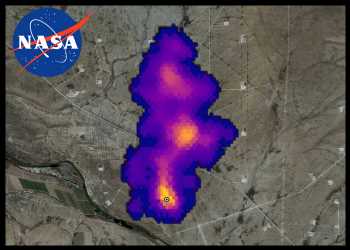
NASA Study Identifies Over 50 Super-emitters Of Methane In Central Asia, Middle East, US
October 26, 2022A NASA study has identified more than 50 “super-emitters” of methane in Central Asia, the Middle East, and the Southwestern United States.
Super-emitters are facilities, equipment, and other infrastructure, typically in the fossil-fuel, waste, or agriculture sectors, that emit methane at high rates.
NASA’s Earth Surface Mineral Dust Source Investigation (EMIT) mission is mapping the prevalence of key minerals in the world’s dust-producing deserts. The aim of the project is to gather information that will advance the understanding of airborne dust’s effects on climate.
The study also detected the presence of methane, a potent greenhouse gas.
“Reining in methane emissions is key to limiting global warming. This exciting new development will not only help researchers better pinpoint where methane leaks are coming from, but also provide insight on how they can be addressed – quickly,” said NASA Administrator Bill Nelson.
The new observations stem from the broad coverage of the planet afforded by the space station’s orbit, as well as from EMIT’s ability to scan swaths of Earth’s surface dozens of miles wide while resolving areas as small as a soccer field.
Relative to carbon dioxide, methane makes up a fraction of human-caused greenhouse-gas emissions, but it’s estimated to be 80 times more effective at trapping heat in the atmosphere in the 20 years after release. Moreover, where carbon dioxide lingers for centuries, methane persists for about a decade, meaning that if emissions are reduced, the atmosphere will respond in a similar timeframe, leading to slower near-term warming.
The mission’s study area coincides with known methane hotspots around the world, enabling researchers to look for the gas in those regions to test the capability of the imaging spectrometer.
“Some of the plumes EMIT detected are among the largest ever seen – unlike anything that has ever been observed from space,” said Andrew Thorpe, a research technologist at JPL leading the EMIT methane effort.
The instrument detected a plume about 2 miles long southeast of Carlsbad, New Mexico, in the Permian Basin.
In Turkmenistan, EMIT identified 12 plumes from oil and gas infrastructure east of the Caspian Sea port city of Hazar. Blowing to the west, some plumes stretch more than 20 miles.
The team also identified a methane plume south of Iran’s capital Tehran, 3 miles long, from a major waste-processing complex. Methane is a byproduct of decomposition, and landfills can be a major source.
Source: Read Full Article


